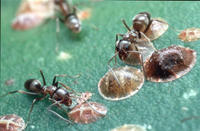-
Tracking Internet searches to predict disease outbreak
The habit of Googling for an online diagnosis before visiting a GP can provide early warning of an infectious disease epidemic. A new study found that Internet-based surveillance has been found to detect infectious diseases such Dengue Fever and Influenza up to two weeks earlier than traditional surveillance methods. Researchers say that when investigating the occurrence of epidemics, spikes in searches for information about infectious diseases could accurately predict outbreaks of that disease.
-
-
Salmonella biofilms extraordinarily difficult, if not impossible, to kill
In the United States, an estimated million-plus cases of Salmonella occurs annually, with 23,000 hospitalizations and 450 fatalities reported each year. Researchers find that once Salmonella bacteria get into a food processing facility and have an opportunity to form a biofilm on surfaces, it is likely to be extraordinarily difficult, if not impossible, to kill it.
-
-
Carbon nanotube sponge helps in water clean-up
A carbon nanotube sponge capable of soaking up water contaminants, such as fertilizers, pesticides, and pharmaceuticals, more than three times more efficiently than previous efforts has been presented in a new study published today. The carbon nanotube (CNT) sponges, uniquely doped with sulphur, also demonstrated a high capacity to absorb oil, potentially opening up the possibility of using the material in industrial accidents and oil spill clean-ups.
-
-
Toxins-breathing bacteria to help industry, environment
Preliminary tests suggest that the bacteria could be used to remove these pollutants from the wastewater and protect the surrounding ecosystems. Buried deep in the mud along the banks of a remote salt lake near Yosemite National Park are colonies of bacteria with an unusual property: they breathe a toxic metal to survive. Researchers believe that this unusual organism may one day become a useful tool for industry and environmental protection – for example, the bacteria could be used simply to clean up the water, but it might also be possible for the bacteria to help humans recover and recycle the valuable elements in the water.
-
-
Healthcare industry to conduct cyberattack drill in March
The American health care industry, in partnership with the federal government, will in March conduct simulated cyberattacks targeting industry networks and resources in an effort to test the industry’s vulnerability to cyberattacks. This will be the first time insurers, hospitals, pharmaceutical manufacturers, and HHS will run coordinated drills. Healthcare is one of seventeen critical infrastructure sectors which, if attacked, could have damaging consequences for the country.
-
-
Massachusetts takes steps to withstand climate change impacts
Governor Deval Patrick of Massachusetts earlier this week unveiled a $50 million plan to help prepare Massachusetts for the challenges climate change poses to energy supplies, public health, transportation, and basic infrastructure in his state. A $40 million grant from the state’s Department of Energy Resources will help cities and towns develop protections around energy services, and $10 million will go toward shoring up critical coastal infrastructure and dam repair.
-
-
Surviving a nuclear explosion in your city

During the cold war, scientists modeled every imaginable consequence of a nuclear explosion. Michael Dillon, a Lawrence Livermore Lab mathematician, found a gap in the sheltering strategies for people far enough from ground zero to survive the initial blast but close enough to face deadly radioactive fallout. Dillon’s model’s addresses the most vulnerable people, those who found shelter from the blast in lightweight buildings, or buildings lacking a basement (these buildings are more easily penetrated by deadly radioactive dust). His recommendations: if adequate shelter is fifteen minutes away, people should remain in their initial, poor-quality shelter no longer than thirty minutes after detonation. If the better shelter is only five minutes away, however, individuals should move there immediately, leaving the closer but unsafe buildings altogether.
-
-
Carbon nanotubes improve flame-resistant coating
Using an approach akin to assembling a club sandwich at the nanoscale, researchers have succeeded in crafting a uniform, multi-walled carbon-nanotube-based coating that greatly reduces the flammability of foam commonly used in upholstered furniture and other soft furnishings. In tests, the flammability of the nanotube-coated polyurethane foam was reduced 35 percent compared with untreated foam. As important, the coating prevented melting and pooling of the foam, which generates additional flames that are a major contributor to the spread of fires.
-
-
Superbugs were found breeding, spreading in sewage plants
Antibiotic-resistant bacteria have been raising alarms for years, particularly in hospital environments where public health officials fear they can be transferred from patient to patient and are very difficult to treat. Bacteria harboring the encoding gene that makes them resistant have been found on every continent except for Antarctica. Tests at two wastewater treatment plants in northern China revealed antibiotic-resistant bacteria —“superbugs” carrying New Delhi Metallo-beta-lactamase (NDM-1), a multidrug-resistant gene first identified in India in 2010 — were not only escaping purification but also breeding and spreading their dangerous cargo. NDM-1 is able to make such common bacteria as E. coli, salmonella, and K. pneumonias resistant to even the strongest available antibiotics.
-
-
New test for detecting newly emerging strains of drug-resistant superbug
Molecular assays for MRSA are used in active surveillance programs to identify colonized patients rapidly. Active surveillance is a proven strategy to reduce transmission in healthcare settings and it helps prevent infection in vulnerable patients. BD Diagnostics has received FDA clearance to market the BD MAX MRSA XT Assay for use on the BD MAX System. This is the second assay from BD Diagnostics capable of detecting newly emerging MRSA strains with the novel mecC gene.
-
-
Reducing radioactivity in fracking waste
In hydraulic fracturing — or fracking — millions of tons of water are injected at high pressure down wells to crack open shale deposits buried deep underground and extract natural gas trapped within the rock. Some of the water flows back up through the well, along with natural brines and the natural gas. This “flowback fluid” typically contains high levels of salts, naturally occurring radioactive materials such as radium, and metals such as barium and strontium. Much of the naturally occurring radioactivity in fracking wastewater might be removed by blending it with another wastewater from acid mine drainage, researchers find.
-
-
Patients infected with drug-resistant bacteria at suburban Chicago hospital
Health authorities in Illinois have placed a suburban Chicago hospital under tight scrutiny after an extremely rare strain of a dangerous drug-resistant strand of flu was found to be connected to a series of operations performed at the hospital. The Centers for Disease Control and Prevention (CDC) has discovered forty-four cases of Illinois patients infected with a particular bacteria, and thirty-eight of those individuals had all recently undergone an endoscopic procedure at Advocate Lutheran General Hospital, located in Park Ridge west of Chicago, in the past year.
-
-
Bioterrorism fears lead scientists to withhold information on new strain of botulism
The recent discovery of a new strain of botulism, the first in forty years, has alarmed California state health officials. The discovery was published in the Journal of Infectious Diseases in October 2013 — but the genetic sequence of the botulism toxin was removed from the report. The decision to withhold the sequencing information took into consideration the fact that there is currently no antitoxin capable of treating an outbreak of botulism, and that it takes about one to two years to develop an antitoxin. Should the classified information reach the wrong hands, a bioweapon, which can be spread as an aerosol, could be used to cause mass-casualty epidemic.
-
-
Improper use of biocides in food production poses public health risks
Biocides used in the food industry at sublethal doses may be endangering, rather than protecting, public health by increasing antibiotic resistance in bacteria and enhancing their ability to form harmful biofilms, according to a new study.
-
-
Killing bugs dead: “Attract-and-kill” technique tackles Argentine ants

After being inadvertently introduced in the United States from South America, Argentine ants have successfully invaded urban, agricultural, and natural settings nationwide. In urban California, the Argentine ant is among the primary pest ants. For example, this particular species of ants makes up 85 percent of ants sampled by commercial pest control companies in just the Greater San Diego Area. UC Riverside entomologists devise a novel “attract-and-kill” technique, which involves mixing a synthetic pheromone in insecticide sprays, to tackle the pest.
-
More headlines
The long view
A Shining Star in a Contentious Legacy: Could Marty Makary Be the Saving Grace of a Divisive Presidency?
While much of the Trump administration has sparked controversy, the FDA’s consumer-first reforms may be remembered as its brightest legacy. From AI-driven drug reviews to bans on artificial dyes, the FDA’s agenda resonates with the public in ways few Trump-era policies have.
